Centenary of the birth of Branko Ćopić




Branko Ćopić (January 1, 1915 - March 26, 1984) was a Serbian and a Yugoslavian writer, born in Hašani, Bosanska Krajina. He completed his primary school in his home town, high school in Bihać and teachers’ college in Karlovac. He graduated from the Philological Faculty in Belgrade in 1940. He published his first story in 1928. His work has been translated into English, German, French and Russian. He was a member of the Serbian Academy of Sciences and Arts and the Academy of Sciences and Arts of the Socialist Republic of Bosnia and Herzegovina.
During the April War, him and a group of friends from Students’ Batallion in Maribor showed resistance against the enemy nearby Mrkonjić Grad. After the Army’ capitulation, he returned to his home town. At the beginning of the uprising, he joined the Partisans together with his close friend and best man, writer Skender Kulenović, from whom he was inseparable. He worked as a war correspondent throughout the war.
After World War II, he spent the rest of his work life and days in Belgrade. He was an editor of children’s papers and one of the greatest writers for children on the territory of the former Yugoslavia. His work largely focused on the everyday lives of the people from Bosanska Krajina and during the NOR (National Liberation War). He won several awards for literature, including one given by AVNOJ (Anti-Fascist Council for the National Liberation of Yugoslavia) and the Njegoš Award (both in 1972).
Ćopić created a diverse body of literary work: a collection of short stories - The Adventures of Nikoletina Bursać, The Marshmallow Color Garden; novels - The Break-out, Silent Gunpowder, Bronze Guards, Don’t Mourn, The Eight Offensive; a collection of poems - Homeland Birth in Flame, Poems, Spring of Warrior, comedies - The Adventures of Vuk Bubalo, The Extinction of Bears.
His most famous works for children are as follows: In the World of Bears and Butterflies, The Partisan Tales, The Pioneer Poems, Hedgehog’s Home, The Stories Beneath a Dragon’s Wing, Rooster and Cat, Experiences of Toscha the Cat, Eagles Start Flying Early, The Tough Teens, Glorious Combat, Head in the Col, Legs on the Horse and others.
Branko Ćopić died in Belgrade on March 26, 1984.
Artistic realization of the stamp: MA Marina Kalezić, academic painter.
Lunar horoscope – the Year of the Goat





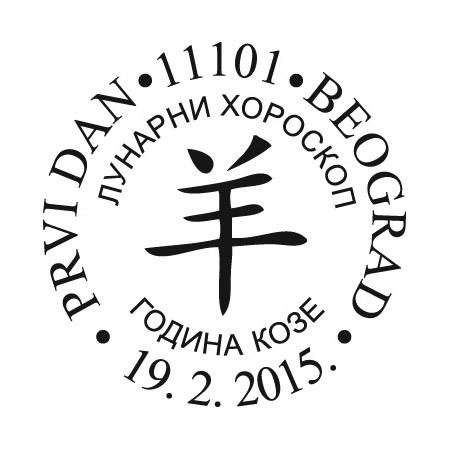
Chinese astrology is based on traditional astronomy and calendars. It also relies on the Chinese philosophy (theory on three harmonies, Heaven, Earth and Water) and the following principles: teaching of Wu Xing, Yin and Yang, Five Planets, 10 Heavenly Streams and 12 earthly branches, lunisolar calendar etc.
The lunar calendar is based on cycles of the moon phase. Most lunar calendars are in fact lunisolar calendars. That is, months are kept on a lunar cycle, but then intercalary months are added to bring the lunar cycles into synchronisation with the solar year. Chinese, Hebrew, and Hindu calendars are lunisolar, as well as most calendar systems used in antiquity. Lunar calendars differ as to which day is the first day of the month. For some lunar calendars, such as the Chinese calendar, the first day of a month is the day when an astronomical new moon appears in a particular time zone.
The Chinese horoscope falls into the oldest known horoscopes. It consists of 12 signs of which each one rules over a lunar year. These Zodiac signs have the names of animals (Rat, Ox, Tiger, Rabbit, Dragon, Snake, Horse, Sheep, Monkey, Rooster, Dog and Wild Boar). In the Chinese horoscope, besides basic signs, very important are also elements: Wood, Metal, Water, Fire and Earth. Every person born in the year of the assigned animal is said to have personalities and traits resembling that animal.
The Year of the Goat starts on 19th February 2015, and it ends on 7th February 2016. It brings us the energy of creativity, abundance and surprises. The Goat is the eighth sign of the Chineese Zodiac. Persons born under this sign are tender, romantic, sensitive and creative artistic souls, quiet and shy, affable, kind and intelligent. On the other hand, they are indecisive, permissive, dependent, insecure and often ungrateful. They are immensely sympathetic, but since they don’t like opposing others, they would rather someone else take the leading role in making important decisions, inasmuch as they contribute to their comfort. Being great artists they find benefactors very easily and they enjoy the company of powerful people.
The good thing is that the Goat is naturally lucky, thanks to its peace-loving nature and good heart. Person born under this sign needs a loyal friend who is stable and trustworthy. With love, approval and admiration, the Goat prospers in any direction of its creativity and is worthy of time and attention given by others.
Artistic realization of the stamps: Boban Savić, М.А, academic painter.
Easter



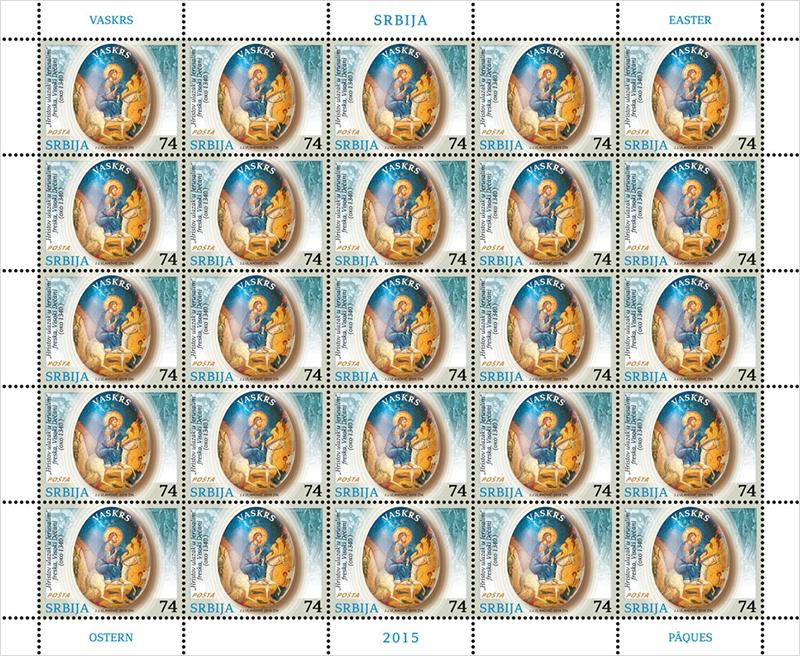
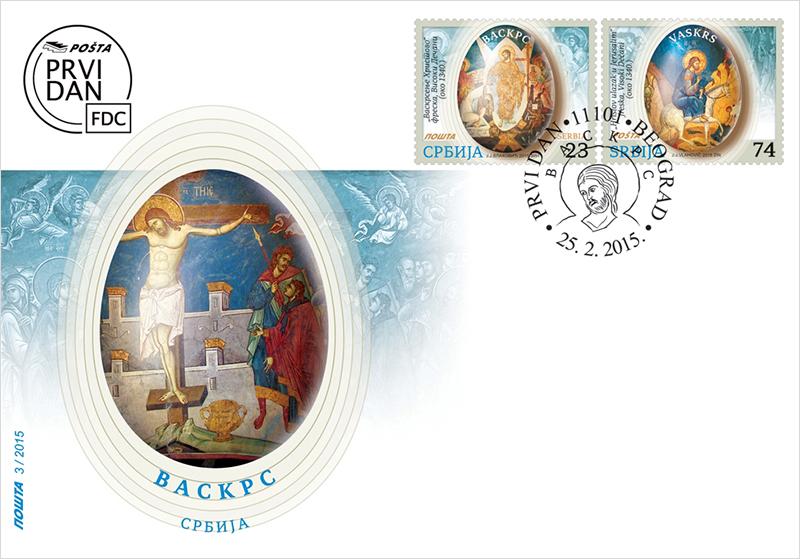

Easter Sunday is the date of the annual celebration of Christ’s resurrection. The Orthodox Church celebrates the Easter on the basis of the Julian calendar. The date is not fixed, but denotes the same season of the year and the same relationship to the preceding astronomical full moon that occurred at the time of His resurrection in 30 A.D.
Easter is one of the most important Christian holidays. This is a day of eternal joy, the day when Christ, the Son of God, conquered the death. By the act of resurrection Jesus Christ proved his divine power and opened the gate of eternal life, joy and happiness that we can find in our faith. On Easter Sunday morning the church bells toll, and the people, together with their priest, go around the church. After the third round they stand in front of the church door. The priest carries the cross, candle and the censer and chants the Easter hymn. The door open and they enter the church where liturgy continues. When it ends, people greet each other with the words: “The Christ has resurrected”, and “Indeed he has”. There are many customs connected with Easter Sunday, and certainly one of them that children like best, is colouring and offering of eggs. The first egg is coloured red and in many parts of our country it is called “The house keeper” and is kept for the whole year, until the next Easter.
Motif on the stamp of nominal value 23,00 RSD: “Resurrection of Christ”, fresco at the northern arch beneath the dome of the Dečani Church, ~ 1340 A.D. Motif on the stamp of nominal value 74,00 RSD: “Palm Sunday – Christ’s Entry into Jerusalem”, fresco at the western arch beneath the dome of the Dečani Church, ~ 1340 A.D. Motif on the envelope: “Crucifixion of Christ”, fresco at the northern arch beneath the dome of the Dečani Church, ~ 1340 A.D.
Graphic realization of the stamps: MA Jakša Vlahović, academic graphic artist.
Expert collaboration: Serbian Orthodox Church, Serbian Orthodox Diocese Raška-Prizren.
Famous Serbian directors



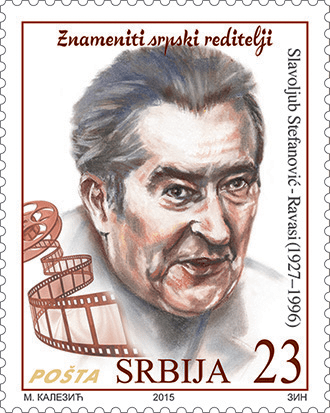

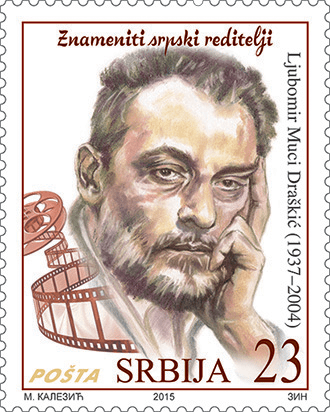



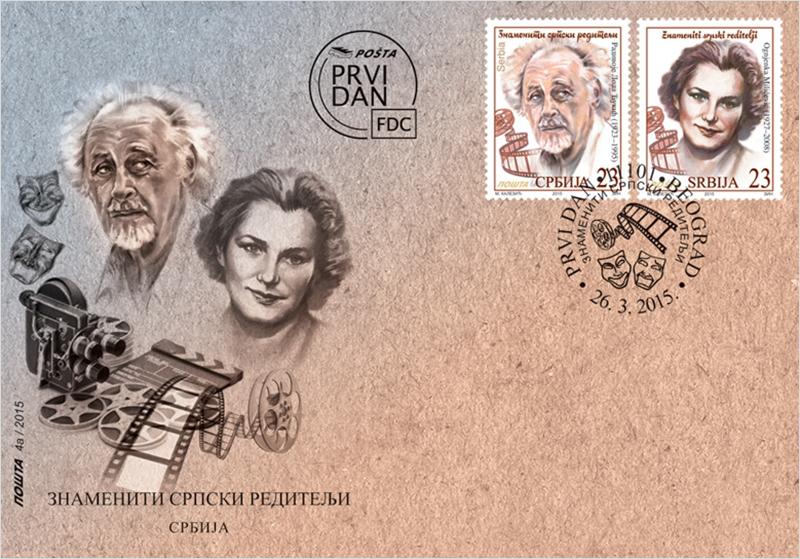




Radivoje “Lola” Đukić, director and writer, born on 3rd April 1923 in Smederevo. Lived in Belgrade, where he finished his studies at the Film School. Worked as a director in Radio Belgrade and Television Belgrade since its foundation. Was the founder of the Humorous Theatre on Terazije in Belgrade, as well as its first director.
Wrote and directed theatre plays such as: Gold Mine, God Has Died in Vain, Budibogsnama, A Man with Four Legs, I must kill Peter, Happy Makers, I Steal, You Steal, They Steal, One Love and Five Dead Men, and the musical Kill or Kiss.
He left behind hundreds of satirical features made for TV Belgrade. He wrote and directed over 200 shows. The works he authored include the TV series The Mirror of a Humble Citizen, Black Snow, Ten Commandments, I Will, You Will, He Will. With Novak Novak, he co-wrote Service Station, On Secret Channel, Wax Museum, Face to Reverse, Sleep Tight, Sačulatac.
He directed the following feature films: Lake, The Ballad of the Cruel One, Greek Children, There Are No Small Gods, A Bag of Luck, The place! Obedient citizen, Golden Sling.
He wrote the books: Sclerotic Memoirs, Sheep on the Boulevard of the October Revolution, Fools eat fog, A Man with Straight Back in the Land of the Hunchbacked. In addition to directing and writing, Radivoje “Lola” Đukić was also a painter. He won many awards: Order of Labour with Red Banner, Order of Brotherhood and Unity with Golden Wreath, Charter for the Construction of Belgrade, and the award by SFERA from Zagreb for the best Science Fiction novel. He died in Belgrade in 1995.
Ognjenka Milićević, director, theatrologist, professor, essayist, born on 26th December 1927 in Banja Luka. She studied directing in Saint Petersburg and at the Academy of Theatre in Belgrade. Graduated in 1952. Worked as director in the National Theatre in Sarajevo, Belgrade, Mostar, including the theatre Atelje 212 in Belgrade, where she directed plays such as: Deep Are the Roots, Romulus the Great, Trees Die Standing Tall, The Trojan Women. In addition to her theatre work, she directed many plays for Radio and Television Belgrade. She was the author of over 100 essays and two studies on theatre: Russian Theatre in the First Half of the 20th Century and On Meyerhold’s Theatre. She was Professor of Directing and Dean of the Faculty of Dramatic Arts. She was also Pro-rector of the University of Arts. For her work, she was awarded numerous awards and honours, including the Grand Medallion of the University of Arts. She was awarded the Order of Merits for the People. Ognjenka Milićević was also a member of the Yugoslav volleyball national team. She died in Belgrade in 2008.
Aleksandar Đorđević was born on 28th July, 1924 in Subotica. Graduated directing from the Academy of Theatre in Belgrade in 1952, in the class of professor Hugo Klajn. Directed a number of plays in the National Theatre in Niš from 1952 to 1961, when he joined the staff of Television Belgrade, where he worked until 1990.
Directed over 200 plays in theatres throughout Serbia, including the Belgrade theatres: JDP (Yugoslav Drama Theatre), Theatre on Terazije, Atelje 212, Boško Buha Theatre. The best known out of these plays were: The End of the Weekend, Fiddler on the Roof, Poltron, Eternal Student, Yalta – Yalta, The Lover. He also directed eight feature films: The Written Off Return, Let’s Fall in Love, Jaguar’s leap, Valjevo train, as well as several TV plays: Mister Seal, Friendship, The Ancient Trade, The cork that is stopping the water. Television audiences remember him by the TV series: Written Off, The return of the Written off, Warm Wind, A Better Life, Happy People, Singles, Lefties.
He won a number of awards for his work: at the TV festival in Bled (1969), Hollywood TV festival (1972), festival in Portorož (1974), the Lifetime Achievement Award of Radio-Television Serbia (1978), the October Award of the City of Belgrade (1984); he was awarded the Order of Labour with Golden Wreath twice, as well as the Order of Bravery. He died in Belgrade in 2005.
Slavoljub Stefanović – Ravasi, born on 29th June 1927 in Čačak. Graduated directing at the Academy of Theatre in Belgrade in 1952, in the class of professor Hugo Klajn. Director of Provincial Theatre in Priština from 1952 to 1957. Directed both Serbian and Albanian plays. The first play he directed was All My Sons by Arthur Miller (1952). In 1957, he joined the staff of Radio Belgrade, and in 1958 he started working for TV Belgrade. The first TV play ever broadcast by Television Belgrade, in 1959, was directed by Ravasi, who also wrote the screenplay based on the play Rental Fee by Branislav Nušić. During his lifetime, he directed 84 television plays and series: At the Magistrate, People, Love Each Other!, The Chronicle of a Small Town Cemetery. He directed his last play, Tesla, in 1993. He also directed feature films, and his best known film is Koštana (1976). He was director or guest director in theatres in Serbia, as well as on TV Skopje, in Warsaw, Budapest, Amsterdam and Munich. He directed his last theatre play in Priština in 1994. It was The Deceased by Branislav Nušić. He died in Belgrade in 1996.
For his work, he received multiple awards at the TV festivals in Bled and in Portorož, as well as the “Bronze Ramesses” award at the TV festival in Alexandria in 1963. He was awarded the Order of Labour with Golden Wreath, Order of Merits for the People and Order of Brotherhood and Unity.
Miroslav Belović, born on 7th August 1927 in Ilidža near Sarajevo. Studied directing in Saint Petersburg, Stratford-upon-Avon and Belgrade. Graduated from the Academy of Theatre in Belgrade in 1951. He was a director, writer and professor at the Faculty of Dramatic Arts (FDU) in Belgrade, as well as the manager of the Yugoslav Drama Theatre (JDP). In addition, he was the artistic director of the theatre AKUD “Branko Krsmanović”. He directed over 130 plays in JDP, in the country and abroad, and over 200 radio plays.
He was the author of around 15 plays. His interest was focused on plays by Yugoslav authors. He directed plays such as: Messrs. Glembay, Bereaved Family, Dundo Maroje, Mister Dollar, Danton’s Death, A Midsummer Night’s Dream, The Hostage, Tango, You Never Can Tell, Captain John Pipplefox, Cinderella. He published the following books: Lyrical Notes, Reign of Illusion, Water in sieve, Autumn Haiku, Second Spring (a poetic homage to his wife, actress Maja Dimitrijević). For his work, he was awarded the AVNOJ Award, the 7th July Award of the Republic of Serbia, the October Award of the City of Belgrade, Vuk Award, Zmaj Charter, “Dr Branko Gavela” award, “Joakim Vujić” award, six Sterija Awards, and the Golden Laurel Wreath of the International Theatre Festival in Sarajevo (MESS). He was laureate of the Order of Labour. He died in Belgrade in 2013.
Ljubomir “Muci” Draškić, born on 20th June 1937 in Zagreb. Graduated directing from the Academy of Theatre in Belgrade in 1962, in the class of professor Vjekoslav Afrić. Brought to Atelje 212 by Bojan Stupica, he worked in this theatre his entire life, at first as a director, and later as the manager. His first directing work was the play The Card Index. In Atelje 212, he directed 33 plays, including Pere Ubu, Bar, Courtroom, Lunatic Asylum, Gladly Goes a Serb into the Army, The Role of My Family in the Revolution, The crazy white stone, Lulu, The Purple Island, The Marathon Family, Radovan III, Hey Serbia, no shade, anywhere, Maria strugles with angels, St. George Slays the Dragon, Duchesse of Folies-Bergères, Mary Stuart, The Escape, The Bourgeois Gentleman. He also directed plays in every other theatre in Belgrade, as well as in theatres in Novi Sad, Sombor, Subotica, Kruševac, Niš, Šabac, Zagreb, Ljubljana, Mostar, Banja Luka, Osijek, Basel, plays such as Alarm Clock, The Gathering Place, The Deceased, Egg, Bereaved Family, A Flea in Her Ear, The Cabinet Minister’s Wife, Dundo Maroje, Madame Sans-Gêne, Tango. As manager of Atelje 212, position which he held for ten years, he succeeded the famous Mira Trailović. He was professor of directing at the Faculty of Dramatic Arts. He directed a number of radio and television plays, such as: Love Over the Phone, Little Bar on the Corner, Generals or Kinship-In-Arms, Under Investigation. For his work, he won many awards: Sterija Award, Golden Wreath of MES in Sarajevo, Golden Turkey at the Days of Comedy in Jagodina, “Bojan Stupica” award, award of the Association of Dramatic Artists of Serbia (UDUS) and award of the festival of theatres of Vojvodina. The square in front of Atelje 212 has been named in his honour. He died in Belgrade in 2004.
Sava Mrmak, born on 4th April 1929 in Zemun. Graduated directing from the Academy of Theatre in Belgrade. Was professor of TV directing at the Faculty of Dramatic Arts in Belgrade and Head of Department of Directing at the Academy of Arts BK. His artistic work started with the play The Teahouse of the August Moon in the National Theatre in Sarajevo in 1954. Since 1958, he worked on Television Belgrade, at first directing musical and variety shows such as In Starlight, Whistle at Eight. He was one of the most prominent Yugoslav directors of historical and documentary drama, such as: The Husino Rebellion, The Man Who Bombed Belgrade, A Bullet in the Back, and TV series, such as: Down the Road of Treason, Breakdown, The Last Act, Španac, Days of AVNOJ, Banjica, Warrior’s Departure - Marshal’s Return, Pillow Of My Grave, The End of Obrenović Dynasty. The last play he directed was Spring in Limassol.
He won many awards: award of the Association of Television Directors, the Lifetime Achievement Award of Television Belgrade, as well as awards for many individual directing achievements, Golden Medallion of the Faculty of Dramatic Arts, Golden Medallion of the Academy of Arts BK, Order of Labour with Golden Wreath. He died in Belgrade in 2002.
Jovan Ristić “Rica”, was born on 2nd April 1939 in Belgrade. He grew up in Molerova Street, graduated from the Third Male Gymnasium in Belgrade, spent his summers participating in youth working actions, almost became a military officer, studied Mechanical Engineering and Law, and finally found his place at the Academy of Theatre, Film, Radio and Television, where he graduated directing in the class of professor Vjekoslav Afrić. In close succession, he founded a number of chamber theatres: Dadov, Teatar levo, Cabaret “Stepenice”, Cabaret “Komarac”. He worked as director in theatres in Mostar, Belgrade, Novi Sad and Zagreb.
He first came to the Television in 1966. He directed the cult TV series Concert for a Young and Crazy World, followed by Wild Years, Our Spectacles, Seven Plus Seven, Once Was, Now Gone, I’ll Do a Little, You’ll Do a Little and 2500 other television shows. He directed over 3000 public events, including eight celebrations of Josip Broz Tito’s birthday. He was one of the founders of the Second Channel of Television Belgrade. He worked for Italian (RAI), German (ZDF), Romanian, Bulgarian, Hungarian, Soviet and Portuguese television stations. He took part in festivals in Warsaw, Dublin, Moscow, Barcelona, Bled, Portorož, winning over 20 renowned awards, including the Golden Rose of Montreux in 1979. He was a passionate collector and one of Serbia’s most renowned philatelists. Thanks to his ideas and his dedication, we now have beautiful series of stamps paying homage to our actors and directors. He died in Belgrade in 2013.
Artistic realization of the stamps: MA Marina Kalezić, academic painter.
Expert collaboration: Association of Drama Artists of Serbia.
Еuropa – old toys






Every object that a child uses to play with can be called a toy. Game is the main children’s activity and an important segment in the period of growing-up and upbringing. In the past, children most often played with the diminished versions of objects from the adults’ world, and that is also the case nowadays. With those toys children were slowly being introduced into their future roles – irons and stoves, dolls and teddy-bears, small pieces of furniture, cars, building bricks, rocking horses...
Besides stimulating and developing children’s imagination, toys are very important educational tools. Diverse skills and intellectual abilities are being developed in the relation between a child and a toy; game stimulates interaction with other children and in that way affects the development of social intelligence. Different games play role in the develpoment of the whole range of abilities: logical-mathematical intelligence, perception of space, shape and their interrelation; knowledge about science and physical forces; about rules and the respect for them; about cooperation, etc. Even the new types of games such as video games, inasmuch as they are propriate and non-agressive, affect children’s development positively – they teach them to be adaptable, to develop imagination, but they are also preparing them for the world of adults which is nowadays greatly affected by computers, technique and technology in general.
Toys exist in every part of the world, they reflect cultures in which they first appeared and they are the product of a certain historical period. Old toys represent social, cultural and economic living conditions of children in the past. By following the develpoment of toys we can also follow the develpoment of technological achievements through historical periods.
Toys were found by archeological excavations of diverse ancient cultures. Historians and archeologists claim that the oldest children’s toys are a flying kite and a spinning top. The history of games is very long; children played for centuries with toys such as balls, spinning tops, dolls, miniature pots, which were made of clay, wood, textile and similar materials. The progress of civilization and of general social conditions led up to the fact that toys have now become available to a greater number of children, thus openning new perspectives for different types of toys as well as for new materials and technologies of production.
Artistic realization of the stamps: Аnamari Banjac, academic painter.
Expert collaboration: Daniela Pejović, Senior Curator, Museum of Science and Technique, Belgrade.
200 years since the Second Serbian Uprising



In the quiet valley of village Takovo, outlined with small rivers Ljeskovica and Dičina, beneath “centennial“ oak tree, or like the locals like to call it the bush, Miloš Obrenović has started, together with the same mind people, one, as it turned out later, extremely complex, but successful process of creating an independent country, by raising the Second Serbian Uprising on Palm Sunday on 23rd of April 1815. After successful battles in Ljubić, Palež, Požarevac, Dublja and after freeing the most of Belgrade pashadom, on the beginning of August 1815 Miloš Obrenović started the negotiations with the Ottoman Porte, i.e. its representatives. For less than two decades, solely through diplomatic means, participants of Takovo uprising created on the territory of one border and in many ways residual province, a vassal Principality within the Ottoman empire with absolute internal self-government. Such status, together with territorial extensions, was recognized and confirmed by the highest legal acts of the Porte, and with edicts in 1829, 1830 and 1833. Prince Miloš was declared hereditary Prince by the special decree. This practically meant the right to build schools, hospitals, churches, monasteries, and also to establish theatres and libraries and to start newspapers. The declaration of the 1835 Candlemas Constitution could be considered as the highlight of this fight, because in addition to the division of powers between the legislative, executive and judicial, and the guarantees to personal and property liberty for every individual, it enabled Serbia to set the foundation for the civil state. Finally, the events in 1815 established the path to the fully independent Serbia, that was confirmed by the decision of the Berlin Congress in 1878.
Motives on the souvenir sheet: The Coat of Arms of the Principality of Serbia; “Такоvo uprising“, Pavle Paja Jovanović, oil on canvas, from the collection of the National Museum in Belgrade; “Takovo cross“ from the Vraćevšnica monastery; The remains of Takovo bush; The monument “Такоvo uprising“, Petar Ubavkić, 1898/99; The portrait of Miloš Obrenović; The monument under the Takovo bush, 1887; The wooden church in Takovo dedicated to Saint George, 1795.
Artistic realization of the stamp: Jakša Vlahović, academic graphic artist.
Expert collaboration: Ana Bolović and Aleksandar Marušić, curators of the Museum of Rudnik and Takovo region.
Science







Jovan Cvijić (11 October 1865 - 16 January 1927), a Serbian scientist, the founder of the Serbian geography and The Serbian Geographic Society, the president of the Serbian Royal Academy, a professor and the rector of the Belgrade University, an honorary doctor of the Sorbonne University and the Charles University in Prague, in his rich scientific and research work equally dealt with geology, geomorphology, social and physical geography, but also anthropology, history and etnography.
Cvijić was born in Loznica, in a family of traders. He finished his primary school and the first two grades of Grammar school in his home town. He finished the 3rd and the 4th grade of Grammar school in Šabac, and afterwards he became a student of the First Belgrade Grammar School. He belonged to the famous generation of graduates whose class-master was the professor Kosta Vujić. He finished studies of the Natural-Mathematical Department of the Grand School in Belgrade in 1888. After graduating, he taught geography for a short period of time at the Second Male Grammar School. He got his doctor’s degree at the Vienna University in 1893 and his doctoral thesis made him famous in the European scientific circles. On his return from Vienna he became a full-time professor of the Faculty of Filosophy of the Belgrade Grand School, and since the foundation of the Belgrade University, on 12 October 1905, Jovan Cvijić was one of the eight full-time professors. He founded the Geographical Institute of the Faculty of Filosophy in 1893, the first institute of that kind in the Balkans. He was one of the founders and the president of the Serbian Geographical Society in Belgrade. In 1912, he started a journal “Gazette of the Serbian Geographical Society” which is still published today.
He was the president of the territorial section of the state delegation at the Peace Conference in Paris after the First World War in 1918 and thanks to his eagerness, the newly-formed Kingdom of Serbs, Croats and Slovenes got its then borders.
He carried out the most important field researches at the beginning of his carieer, and his geomorphological representation of the terrain in the Balkan Peninsula published in the two-volume book of “Geomorphology“, represents even today, a significant basis in contemporary geomorphological researches. He was the rector of the Belgrade University two times, an honorary doctor of Sorbonne and the Charles University in Prague, a regular member of the Serbian Royal Academy and its president from 1921 until his death.
He died on 16 January 1927. He was burried at the New Cemetery in Belgrade.
Artistic realization of the stamp: Anamari Banjac, academic painter.
Joakim Medović (Joachim Medowic), Polish by his origin, a doctor and a writer, a medical doctor, is one of the first Serbian doctors and one of the founders and the first president of the Serbian Medical Society.
He was born on May 8, 1815 in Podvizov in Galicia, today’s Poland, and finished philosophy in Lavov and medicine in Vienna, and came to Serbia as a medical doctor and a surgeon and a master of obstetrics in 1842. By a decree of Prince Aleksandar Karadjordjevic he was appointed a physicus of Pozarevac district.
Very diligent, dynamic and curious, Dr. Medowic applied in his work some new methods of population treating, at the same time working on the improvement of health culture of the population. By the order of the Minister of the Internal Affairs, he moves with his family to Belgrade, on the position of the Secretary of the Medical Ward in the Ministry of Internal Affairs. He participated in the organization of the medical service and the improvement of education in the field of medicine in Serbia. He taught forensic medicine in the Great School, and in 1865 he published the first medical textbook for higher education in Serbia, “Forensic Medicine for Lawyers”. He published the second volume of this textbook during the following year, and in 1869 he published the book “Minor Surgical Services and First Aid in Body Injuries”.
He was one of the greatest authorities in the field of medicine in Serbia. He participated in the organization of the medical service and was one of the creators of the health legislation. Being one of the most educated people of his age, he spoke Polish, Slovak, French, German and Latin language. He became a corresponding member of the Society of Serbian Slovesnost in 1847 and was chosen for a regular member of the Serbian Learned Society in 1864. He performed his duty of the Secretary of the Department for Natural and Mathematical Sciences from 1869 to 1870, and when the Serbian Medical Society was founded in 1872 on the initiative of Vladan Djordjevic, he was its first president. He was one of the creators of the magazine “Serbian Archives of Medicine”. He was elected an honorary member of the Serbian Royal Academy in 1892.
He died in Belgrade in 1893. He was buried in the New Cemetery.
Artistic realization of the stamp: Anamari Banjac, academic painter.
International Telecommunication Union’s 150th Anniversary
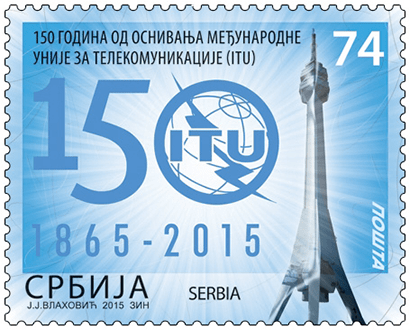



On 17 May 2015 ITU the International Telecommunication Union (ITU) will be celebrating its 150th anniversary. For a century and a half ITU has been at the center of advances in communications – from telegraphy through to the modern world of satellites, mobile phones and the Internet. One of the most remarkable advances of the past 150 years has been the incredible increase in both the speed and variety of human communications.
The story of ITU is one of international cooperation in the field of telecommunication. ITU was founded in 1866 in Paris, when twenty European states signed the first International Telegraph Convention and created the International Telegraph Union. In 1932 in Madrid, the International Telegraph Conference and the International Radiotelegraph Conference decided to merge into a single entity and – reflecting its mission for all communication technologies – to give ITU the modern name that it still has today.
In 1947, two years after the foundation of the United Nations, ITU became part of the UN family, as a specialized agency for telecommunication.
At the Additional Plenipotentiary Conference held in Geneva in 1992, the new ITU Convention and the new ITU Constitution were signed. ITU’s new structure was organized into three sectors, dealing with development, standardization and radiocommunication.
ITU’s continuing mission is to achieve the best practical solutions for integrating new technologies as they develop, and to spread their benefits to all. Digital inclusion is an essential part of ITU’s endeavors to connect the world. To promote expansion of new technologies, ITU, together with UNESCO, established the Broadband Commission in 2010. 150th anniversary will celebrated by all ITU’s members – governments of 193 countries, and more than 700 sector members and associates.
Artistic realization of the stamp: Jakša Vlahović, academic graphic artist.
Expert collaboration: Dr. Milan Janković, Executive Director, Republic Telecommunication Agency (RATEL).
European nature protection






Nature Park “Šargan – Mokra Gora” includes valleys of Mokra Gora and Kreman, southeast areas of Tara mountain, northwest parts of Zlatibor mountain and mountain pass Šargan. In this area, as part of the large forest complexes, especially significant are forests of black and white pine, because this area is their natural habitat.
The fact that explains the exceptional botanical richness is that this relatively small area is inhabited by about 22% of the total Serbian flora. Regarding the fauna, especially valuable are the birds, because from 60 registered species in the area, 29 are rare species. Among mammals that live here are wolf, brown bear, otter and wild cat. Very narrow railway “The Šargan Eight” represents the special value of this area and it is world famous for a technical solution of overcoming great climb on a small distance. Along the railway line there is a larger number of old locomotives and wagons, which are protected as monuments of technical culture.
The area of the Nature park represents the part of potential international biosphere reserve “Drina” (UNESCO, MAB) which includes the space of the Republic of Serbia and the Republic of Srpska (BiH). Based on the Studies of nature protection of the Institute for nature conservation of Serbia, area Šargan – Mokra Gora in 2005 became a Landscape of exceptional features, as a natural area of great importance I category, and in 2008 it received the status of the Nature Park, of an area of close to 10.814 hectares.
Special Nature Reserve „Goč – Gvozdac” represents an extremely forested mountain area, which is like a forest mosaic of indigenous tree species of Serbia, and it was declared a scientific-research centre and as such it is being developed for over 50 years under the management of Faculty of Forestry, University of Belgrade. It is located in the central part of the Republic of Serbia, and is characterized by rich forests, springs and wells of healthy mineral waters. Thanks to its geographical location and climatic characteristics, and also to the relief and geological substrate, it is a habitat of a large number of plant and animal species.
Specific phenomena of Goč is the mixed forest of fir, beech, black pine and sessile oak. Beginning at 1300 m above sea level to the very top – Crni vrh (1543m), there is an endemic Balkan Peninsula mountain maple (Acer heldreichii var. Pancic), and a variety of black pine (Pinus nigra var. Gocensis). Otter (Lutra Lutra) lives in Gvozdac and Brezan rivers, as well as in the wider area of Goč, which is legally protected as a natural rarity, while the European and World Red lists marked it as vulnerable (VU). In order to protect the natural features of the area, the Institute for Nature Conservation of Serbia did a study for protection of special reserve “Goč – Gvozdac” as a professional base of the proposal for the status of protection of an area of 3,957 hectares, as a I category natural area of great national importance.
Artistic realization of the stamps: Miroslav Nikolić. Professional cooperation: Nataša Panić, curator, Institute for Nature Conservation of Serbia, Belgrade.
Flora








Quince (Cydonia oblonga Mill.)
It is believed that quince (Cydonia oblonga Mill.) has originated in Asia Minor, and via Ancient Greece and Rome it spread further into Europe. Its botanical name stems from the name of Greek city Kydonia (present-day Chania) at Crete. The quince tree is 4-6 m tall, and in Armenia and Iran it may be found in natural populations. Quince fruit is similar to apple and pear fruit. It has high biological value as well as prophylactic and therapeutic significance. The fruits contain a large amount of cellulose, tannin and pectin, so they are rarely used fresh and instead mostly processed (juice, preserves, compote, jelly, jam, brandy). Leskovačka dunja is an old native sort with high-quality fruit. It is farmed in Podunavlje and Pomoravlje (areas around rivers Danube and Morava) as well as in Macedonia and Bulgaria. The fruit is shaped like an apple, up to 400 g in weight, with few stone cells. It is used processed. Vranjska dunja is an old variety of unknown origin, also known as dunjac. It was recorded in vicinity of Vranje. It has very large fruit of pear shape, sometimes up to 500 g in weight. It is used for production of fruit juice.
Apple - The Budim (Malus sylvestris L.)
Budimka is an old domesticated variety, supposedly brought from the East. The tree has a luxuriant crown and may reach old age. Crown is tall and may bear a large yield of fruit. This variety thrives best in moist, well aerated soil. It is resistant to most plant diseases and suitable for organic production. In Serbia, Budimka has been farmed for over 800 years.
Plum - The Early Bird (Prunus domestica L.)
This is an autochthonous variety of our region and one of the best known brandy types of plums, with highest quality. It is believed to have originated in village Darosava near Aranđelovac in Šumadija, leading to its vernacular name darosavka. The tree is of medium stature and with widely pyramidal crown. The brittle branches are easily broken, particularly due to weight of crop yield or due to strong wind. Fruit is small, ellipsoidal, and reddish-blue in color. This variety thrives even on poor, drier soils. It is relatively resistant to fungal diseases and partially susceptible to plum pox virus. Fruit of ranka is eaten fresh or made into jam.
Among the brandy types of plums it is known for high crop yield, while the produced brandy is of top quality. Besides being used for famous slivovitz, ranka plum is a favorite variety mentioned in folk songs, belonging to the oldest original Serbian tradition.
Pear - The Karaman (Pyrus communis L.)
Old, naturalised variety of pear, originated from Asia Minor, from area Karaman. Until the Second World War this was the most common pear variety in the region of Serbia, Bosnia and Macedonia. Presently it is rare, but it still may be found in the catchment valley of Zapadna Morava Region, in Vranje Valley, Toplica, Raška and Metohija.
Fruit is medium-sized, pear-shaped, asymmetrical with characteristic pronounced bumps. The flesh of the fruit is yellowish, melting, juicy and sweet, with characteristic musky smell. It is suitable to be consumed fresh and also for making jam.
Има здраво и дуговечно стабло, а крошња је са ретким гранама обореним према земљи, по чему се лако распознаје. Ова сорта је осетљива према чађавој краставости и фузикладијуму. Погодују јој влажна и плодна земљишта. Добре је родности, и може да донесе преко 200 кг плода по сезони. Сазрева крајем јула, током августа па све до септембра и може да се бере у више наврата.
Artistic realization of the stamps: Miroslav Nikolić
Expert collaboration: Aleksandra Savić, higher currator of Natural History Museum in Belgrade.
60th Anniversary of the radio show “Good morning, children”



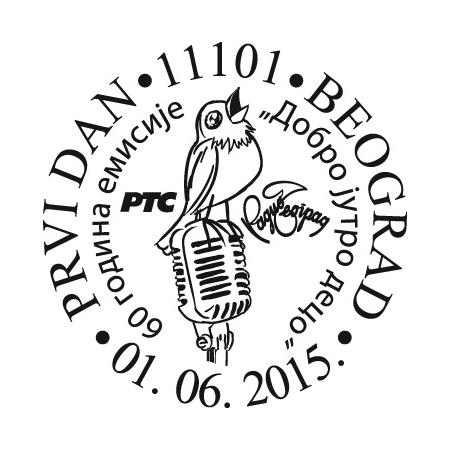
Being sixty, is it a little or a lot!?
If you ask the Program for Children and Youth of Radio Belgrade 1, that is: WONDERFUL!
The radio show “Good morning, children” is just that old.
The idea was Duško Radović’s, who brought it to the waves of Radio Belgrade and let it flow. All these years, everyone who wrote, edited, directed, and acted which was emitted every morning at 7:05, cherished, guarded and loved that strange bird, which actually wasn’t that: It’s actually Mića Tatić chirping.
Even today, 60 years later!
Motif on the stamp: portraits of Duško Radović and Mića Tatić.
Artistic realization of the stamp: Jakša Vlahović, academic graphic artist.
Expert collaboration: Vesna Ćorović Butrić, editor-in-chief of the Program for Children and Youth of Radio Belgrade 1.
175th anniversary of the Post of Serbia



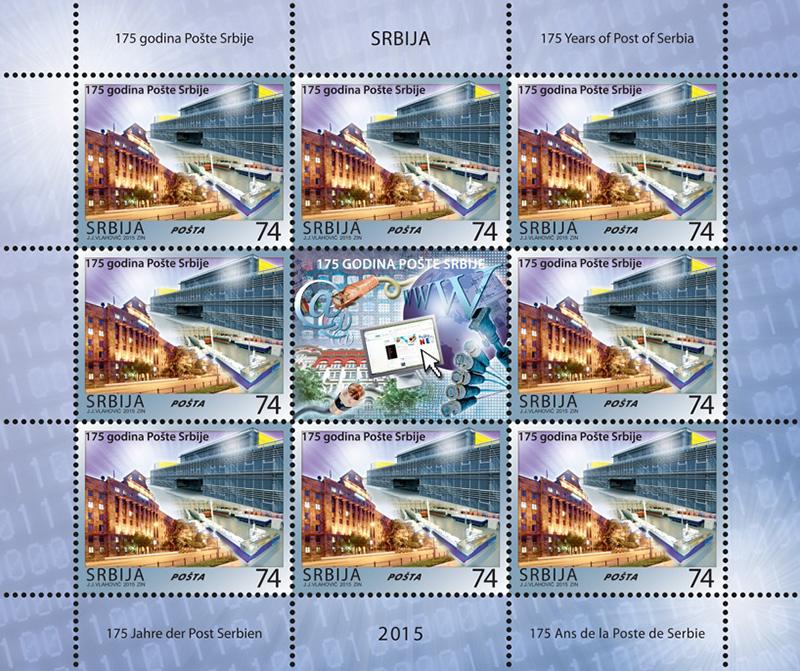




In the 19th century, after gaining partial autonomy, Serbia began opening and developing all institutions necessary for the functioning of a state - schools, hospitals, printing houses, and among them, a postal institution, as equally important.
During its existence, Post of Serbia has always been in line with contemporary trends, which included a quick, accurate and efficient service, and in many ways it has contributed to the industrialization and modernization of our country – by introducing telegraphic traffic in 1855, public postal transport for passengers in carriages in 1866, public telephone traffic in 1899, and in later decades with many other technological innovations.
In 1866 Principality of Serbia has printed its first postal stamps. The first regular postal stamp, with the image of Prince Mihailo Obrenović, was maid by engraving, in Vienna. Since then and up to now, Serbian stamps have been valued in the world as valuable works of art.
Principality of Serbia was also one of the founders of the Universal Postal Union, in 1874.
Since 1865 and its first intentionally built post office building (next to Batal Mosque), Post of Serbia has built facilities that helped with their shape, size and space organization in increasing the productivity of postal, telegraphic and telephone services.
In 2014 Post of Serbia officially opened and put into operation a new Regional postal logistic centre “Beograd”. The centre will contribute, with its 28.000 square meters of modern business, warehouse and sorting space and state of the art machines to the higher quality of services and the introduction of new services in domestic and international postal traffic.
In this way, Post of Serbia still remains one of the leaders in technological and economic development of modern Serbia.
Artistic realization of the stamp: Jakša Vlahović, academic graphic artist.
Expert collaboration: Ljiljana Đorđević, curator of the PTT Museum in Belgrade.
Art









125 years since the birth of Petar Dobrović
Petar Dobrović (Pécs, Austria-Hungary, 14.01.1890 – 17.01.1942, Beograd, Yugoslavia) was born in the family of the Serbian merchant Petar Dobrović of Pécs, in the then Austro-Hungarian monarchy. He studied painting at the Academy of Fine Arts, Budapest. During his first stay in Paris 1912-1914, his work was influenced by cézanism and cubism, evident mostly in the series of drawings.
Politicaly active, in 1918. he participated in the military mutiny in Pécs, was imprisoned and run away for Novi Sad (Serbia); later on, in the 1921, after his return to Pécs, he became the president of the small and shortlasted (eight days) Baranya-Baya Serbo-Hungarian Republic, in consequence of which he was sentenced to death in absentia. After that event he moves to Belgrade.
From 1927-1930. during his transition art period, Dobrović introduces into his paintings pure color. Third, and the most important period of his art work lasts form 1931-1941, during which he connects highly colorist with expressionist approach: pure color, emphatic gesture, hedonism and modernism.
Dobrović spends his summers on the island of Hvar and in the town of Dubrovnik, where he associates with artists, writers and intellectuals. His main idea was to create “monumental 20th century art”. Following the growth of Serbian and Yugoslav modernism he is the one of the best representatives of the painting of the third decade of constructivist and synthetic painting, and even more, of the forth decade of colorist painting.
From 1923 to 1925 Dobrović lectured at Artistic school in Belgrade. He was one of the founders of State Art Academy in Belgrade (later Fine Arts Academy) and one of the first professors. He also was one of the founders of the modernist art group Oblik (“The Form”). He wrote art reviews in German for the Pariser Deutsche Zeitung, and art critics of Belgrade exhibitions in the daily Politika and the periodical of SKG. At the Kolarac people’s University Dobrović held the figurative paintings course.
He has exhibited in numerous group exhibitions in the country and in Europe, in Paris, Budapest, Prague, Belgrade, Dubrovnik and Venice, and had his first solo exhibition in his hometown of Pécs in 1913. In 1938 he exhibited at the XXI Biennale in Venice. He died in Belgrade on Savindan 1942. He was buried at the New Cemetery.
Graphic realization of the stamp: MA Marina Kalezić academic painter.
Expert collaboration: Žana Gvozdenović, museum advisor.
Museum of Contemporary Art, Petar Dobrović’s Gallery, Belgrade.
200 years since the birth of Dimitrije Avramović
Dimitrije Avramović (Saint Ivan Šajkaški, 15 March 1815 – Novi Sad, 1 March 1855) was a painter and a writer, one of the originators of Romanticism in Serbian painting and one of the originators of Serbian caricature. He finished primary and grammar school in Novi Sad, and he studied painting at The Vienna Academy from 1836 – 1840. In Vienna, he belonged to the social circle around Vuk Karadžić, who recommended him as a painter to Prince Mihailo.
Dimitrije Avramović predominantly dealt with visual arts, but at the same time he researched the artistic past and wrote about it for the purpose of historical painting. He visited monasteries in Serbia (Ravanica, Manasija), and in 1847 he travelled to the Holly Mount of Athos.
Dimitrije Avramović travelled to the monasteries of Manasija, Ravanica and to their surroundings in September 1846 with a view to researching and copying the old artistic monuments. He drew four architectural drawings from the collection of the Gallery of Matica Srpska (The Manasija Monastery, The Gate of The Despot’s Inn and The Dining Room of Prince Lazar) outdoors with the intention of faithfully copying the state of what he saw and they represent the oldest document of the expert research of antiquities in Serbia. Avramović’s initiative, which was approved by the then Ministry of Education, is even more important when the complex historical – political circumstances are considered in the Principality of Serbia, dependent on the supreme authority in Constantinopole. Avramović intended to use the material collected during the research for the renewal of the national historical monumental painting. This first journey resulted in the deepening of Avramović’s interest in antiquities. Concluding that the source of the Serbian fresco painting is further to the south, in the spring of 1847 he travelled to Thessaloniki, The Holly Mount of Athos and Constantinopole, and afterwards he published two books on the antiquities of Athos. In the preface of the book The Holly Mount Viewed from the Perspective of Faith, Art and History, Belgrade 1848, thrilled by the national achievements, comparing our cultural heritage with the world’s one, Avramović wrote that even:”....Raphael and Michelangelo and Correggio and Tizian and Rubens and all of the biggest historical fresco painters after them would have gladly been Serbians…” if only they had known about the famous events from the Serbian history.
Besides literal and translation works Avramović also left texts from the field of aesthetics, painting critique, theory and history of art. He died in Novi Sad in 1855.
Graphic realization of the stamp: MA Marina Kalezić academic painter.
Expert collaboration: Milena Vrbaški, museum advisor.
The Gallery of Matica Srpska, Novi Sad.
International Year of Light






On 20 December 2013, the UN General Assembly 68th Session proclaimed 2015 as the International Year of Light and Light-based Technologies (IYL 2015).
The International Year of Light is a global initiative which comprises a series of coordinated activities on national, regional and international levels, aiming to inform all citizens of the world about the importance of light and light-based technologies in their daily lives, their future, the development of society and art, and overall social progress.
Light is one of the initiators of the process of photosynthesis, an essential factor for the development of the biosphere and the evolution of the human species. The light plays a central role in human activities starting from the understanding of the world through the sense of vision, artistic expression, modern communications, Internet, to the development of the fundamental concepts that allow us to understand our place in the Universe and record the events in time and space. Application of light-based technologies gave revolutionary contribution to the development of medical diagnostics and treatment, telecommunications, energy efficient manufacturing, media, art and culture, and thus improve the health and overall quality of life.
Almost all scientific fields are based on the theories of light and its interaction with matter, and light is also the main messenger in the study and our understanding of the Universe and subatomic world. The history of the study of light spans centuries, while the modern science of light was born in the 20th century. Today light and light-based technologies become key disciplines in science and technology of the 21st century.
Expert collaboration: Dr. Petra Beličev, P* Group, Vinča Institute for Nuclear Sciences, University of Belgrade.
Artistic realization of the stamps: Boban Savić, М.А, academic painter.
World Football Champions U 20 – New Zealand 2015



Serbian national team under 20 (U-20), lead by a brilliant team coach Veljko Paunović won the FIFA U-20 World Cup in New Zealand, at the tournament which took place from 31 May to 20 June 2015. This is the first world title for Serbia in football. The same glory was acquired by the generation of the “Chileans”, under the name of Yugoslavia in 1987.
Within the competition of 24 best world teams, “eaglets” were the best team in New Zealand and deservedly raised the cup in Auckland on 20 June. The success of the “New Zealanders” is based on four pillars: enthusiasm, responsibility, respect and trust. Our heroes’ path wasn’t easy. According to the draw, they had to triumph in the “group of death” in Dunedin with Uruguay (0:1), Mexico (2:0) and Mali (2:0). In the eighth finals in Dunedin they first defeated Hungary in the horrific end-game with two extra times (2:1). A catchword “God entrusts His best missions to His best chosen ones” written on the jersey, Paunović’s chosen ones confirmed in the quarter finals against USA in Auckland achieving victory on penalties (6:5). In the semi-finals Mali was defeated again 2:1. When children make their first steps in football, they daydream about playing in the finals of the World Cup against Brazil.
This dream came true for the “New Zealanders” in Auckland at the packed stadium “North Port”. The historic goal of Nemanja Maksimović in 118th minute brought an enormous celebration in Auckland and the entire Serbia, the title of the world champions, joy to the nation and hope in the better future of the Serbian football. The finals to remember: Serbia – Brazil 2:1.
Goalkeepers: Predrag Rajković (FC Crvena zvezda), Vanja Milinković Savić (Manchester United), Filip Manojlović (FC Crvena zvezda). Defence: Miloš Veljković (Tottenham), Srđan Babić, Radovan Pankov (FC Vojvodina), Miladin Stevanović (FC Partizan), Nemanja Antonov, Milan Gajić (OFK Beograd), Stefan Milošević (FC Spartak), Vukašin Jovanović (FC Crvena zvezda). Midfielders: Nemanja Maksimović (FC Astana), Sergej Milinković Savić (KRC Genk), Saša Zdjelar (Olympiacos FC), Mijat Gaćinović, (FC Vojvodina), Filip Janković (Catania), Marko Grujić (FC Crvena zvezda). Forward: Staniša Mandić (FC Čukarički), Stefan Ilić (FC Spartak), Ivan Šaponjić (FC Partizan), Andrija Živković (FC Partizan). Coaching staff: Veljko Paunović (Team Coach), Mitar Mrkela, (Director, Chief of the Delegation), Marko Mitrović (Coach), Milan Kosanović (Coach), Aleksandar Sarić (Goalkeeping coach), Petar Milčanović (Specialist in Physical Preparation), Nikola Leposavić (Specialist in Video Analysis), Dušan Gelić (Team Manager), Dr. Pavle Maksimović (Physician), Viktor Vujošević (Physiotherapist), Srđan Branković (Physiotherapist), Vladimir Borković (Psychologist), Igor Gačić (Media Officer), Miljan Stanojević (Security Officer), Nenad Dragaš (Steward).
Graphic realization of the block: Jakša Vlahović, academic graphic artist.
Expert collaboration: Football Association of Serbia.
Joy of Europe


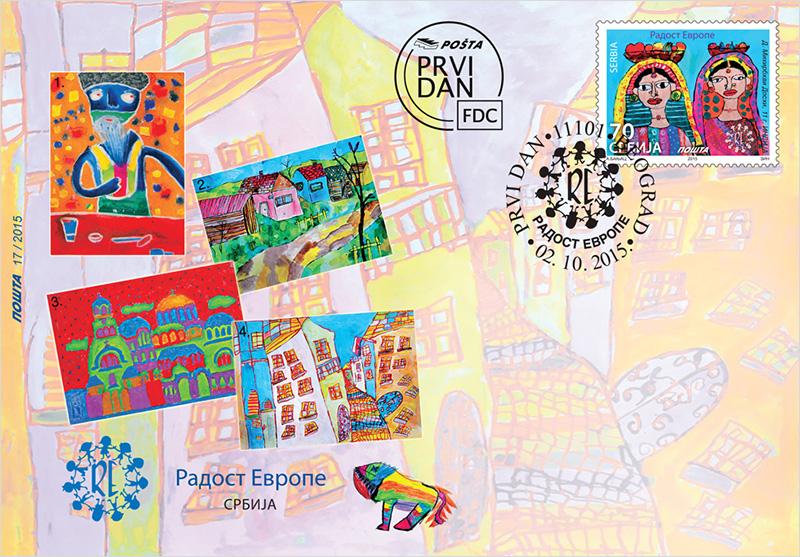

“Joy of Europe” is the biggest and the oldest international event of children’s creativity, organised ever since 1969 on the occasion of the Children’s Day. Every year at the beginning of October the children from a range of European countries come to Belgrade to dance, sing, act, display their works of art, but first of all, make friends and have a good time. There is almost no European country whose children have not been here as a guest at this 46-year long event “Joy of Europe”.
A part of “Joy of Europe” since 1998 has been the international art competition under the same name, with the topic always being “The Dictionary of Friendship”. A great writer and children’s friend Duško Radović put together fifteen universal symbols (child, Europe, bread, play, book, love, mother, peace, father, song, friend, bird, joy, freedom, sun) connecting children all around the world by dancing, singing and finally by image.
For the fourteenth time since its foundation, the exhibition of the International Art Competition presents the most successful works of young artists from Serbia and abroad who with their colourful palette of artwork make the international event Joy of Europe even more beautiful. Every year, the prized works evidence the authenticity of visual culture of childhood, developing sensibility of both the audience and the professional public for this form of artistic expression.
At the contest, the children works are divided into five categories for children between five and eighteen. Over the time, the contest expanded much beyond the boundaries of Europe, bringing together children and youth from the entire world. The best works find their place also on the special issue stamp “Joy of Europe”. This year, the work of ten-year-old child from India, Dhanui Mihirbhai Doshi, the winner of the art competition, is used as a template for the art solution of the stamp. The art work of six-year-old Konstatin Krnjić from Serbia, found its place on a vignette, and as a motif on the envelope are also shown the works of Alice Panchal (5 years) from Australia, Tomaš Kaleja (13 years) from Slovakia, Lora Muteva (10 years) from Bulgaria and Tomaš Bilý (13 years) from Slovakia.
Expert assistance: Children’s cultural centre Belgrade.
Graphic processing of stamp: Anamari Banjac, academic painter.
Centenary of the great defence Of Belgrade in the First World War
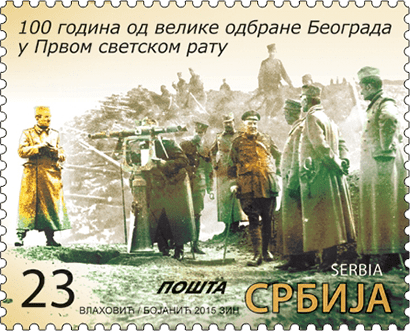

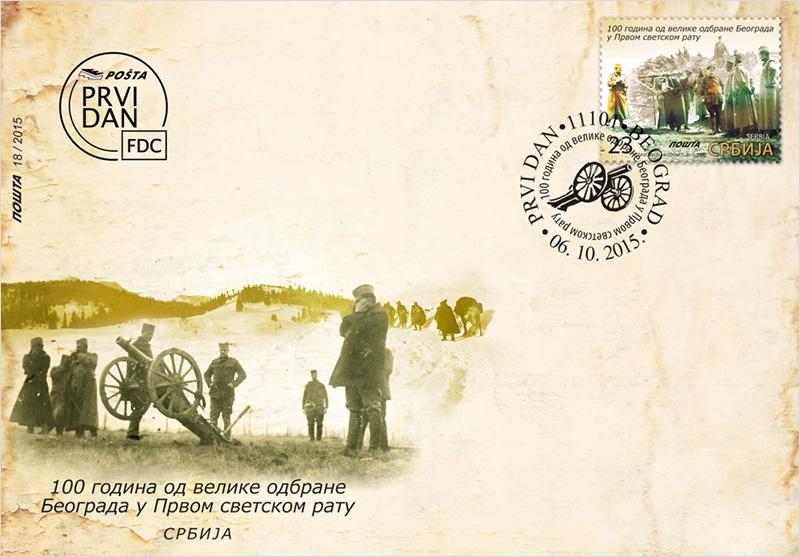

Wartime in 1914 completely depleted the Kingdom of Serbia. The economy collapsed and citizens, a lot of them being refugees, were hungry and affected by epidemic typhus and dysentery. Civilians, soldiers, children and the elderly were all dying together with the doctors who were treating them.
In September 1915 Austro-Hungarian and German troops gathered 800.000 soldiers for the new offensive against Serbia, which barely had 300.000 soldiers, poorly equipped. The offensive began with bombing of Belgrade on 5th October 1915. Over 30.000 shells fell on Belgrade in just two days. Enemy army tried to cross the Danube on 7th October, supported by heavy artillery fire. It was only after a dozen of unsuccessful charges that Austro-Hungarian forces managed to cross the river. Under the fierce onslaughts of enemies, the defenders had to retreat from Danube quay first to the Dušanova Street, and then to Vasina Street. Fierce fights lasted for three days. Belgrade was defended, besides the soldiers, by women, children and old men, who took guns from dead soldiers.
Faced with the lack of artillery weapon, ammunition, equipment and food, Serbian army left Belgrade and retreated to the south of the country with a strong resistance. In those difficult moments, the whole nation fought together with the army.
Plan of the high command to retreat the army through the valley of Morava towards Greece and Thessaloniki port was hampered by the attack of Bulgarian units that invaded the south of Serbia without a declaration of war. Despite being faced with complete failure, Serbian army refused offered capitulation and continued the fighting. In November 1915 high command ordered the retreat across Albania in order to reach Durres port, from where the army would be transferred to the safe Greek soil.
The retreat of Serbian army across Albania, followed by the convoy of refugees and the entire state leadership headed by King Petar I Karđorđević, is rightfully called Golgotha of Serbia, because it represented the hardest experience for Serbian army and nation since the beginning of the Great War.
Motif on the stamp: Regent Alexander and the British admiral Thrubridge on the position of the defense of Belgrade. Motif on the envelope: the defense of Belgrade 1915, the moment to fire a fieldpiece.
Artistic realization of the stamp: Jakša Vlahović, academic graphic artist and Radomir Bojanić, academic painter.
Expert collaboration: Ministry of Defence and Serbian Armed Forces.
100th Anniversary of patents of Michael Idvorsky Pupin – dawn of telecommunications




UNESCO proclaimed 2015 as the International Year of Light and Light-based Technologies. The program includes discoveries in the field of optics, photonics and electromagnetic signal transmission, and it also marks the 100th anniversary of registering seven patents of Michael Pupin from the field of radio-waves emission.
The light made revolution in the filed of energy, education, agriculture, health and communications. Mesmerised by the light, Pupin understood the lighting not only as a technological innovation, but also as a cultural change.
Michael Idvorsky Pupin (1854-1935) was a scientist, professor, winner of Pulitzer prize, Honorary Consul of Serbia in the USA, long-term president of the Serbian National Alliance in the USA, great benefactor and patron.
During his many years of scientific and experimental work, Pupin gave significant contribution to the field of multiple telegraphy, wireless telegraphy, telephony, radiology and development of electrical engineering.
With his patents from 1915, he laid the foundations for the long-distance multi-wave transmission of radio signals by electronic transmitters, thus creating the basis for the development of radio techniques and all forms of modern wireless communication.
Artistic realization of the stamp: MA Boban Savić, academic painter.
Expert collaboration: Ljiljana Đorđević, curator of the PTT Museum in Belgrade.
Christmas
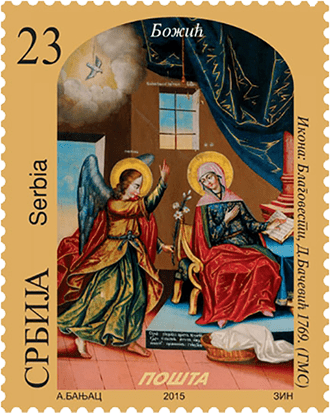

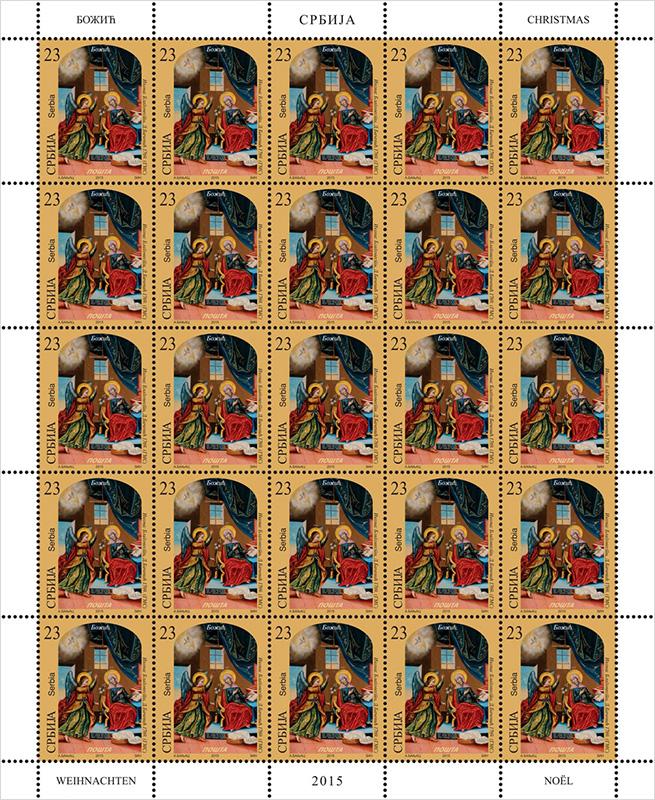


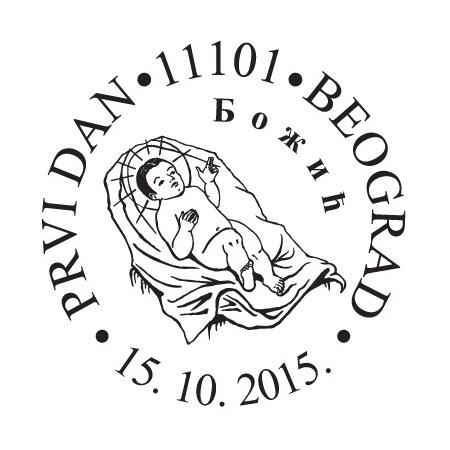
The entire Christian world celebrates the Nativity of Chirst holidays on 25th December. However, three Orthodox Patriarchates - Jerusalem, Russian and Serbian, count the time according to the Julian calendar, and their believers, due to the difference of 13 days, celebrate Christmas on 7th January.
Christmas is considered as one of the most important and joyful Christian holidays, and its message is message of peace and love.
Christmas in Serbia is commemorated three days. This is, above all, a family holiday, marked with numerous ancient traditions. On the eve of Christmas, so-called Badnji Dan (Day before Christmas), Badnjak (an oak-tree yule log) is brought into the house, a vigil lamp is lighted, and straw scattered across the floor, together with some sweets, prunes, walnuts, sugar cubes and coins hidden. The straw is there to symbolise the Nativity scene, the yule log is a symbol of longevity and steadiness of Christianity, and the warmth of love that Christ brings to us by His birth and arrival to the Earth. On the Christmas day, early in the morning, the church bells toll and announce the arrival and birth of Christ. The people go to church to the Christmas Liturgy and greet one another: “Christ is Born!”, answering: “He is truly Born!”.
Motive on the stamp with a face value of 23.00 dinars: The icon of the Annunciation, by D. Bačević, 1769, from the collection of the Gallery of Matica Srpska. Motive on the stamp with a face value of 70.00 dinars:The icon of the Adoration of the Kings, by N. Nešković, 1763, from the collection of the Gallery of Matica Srpska. Motive on the envelope: The icon of Madonna with Child, by an unknown author, 18th century, from the collection of the Gallery of Matica Srpska.
Icon and engravings are located in the collection of the Matica Srpska Gallery in Novi Sad.
Expert collaboration: The Gallery of Matica srpska, Novi Sad.
Serbia’s Chairmanship of the Organization for Security and Co-operation in Europe (OSCE)




Chairmanship of the Organization for Security and Cooperation in Europe was recognized by Serbia both as an honor and as a great challenge in the field of multilateral diplomacy, a recognition that we are a reliable partner, one up to the responsibility for reaching consensus in such a diversified Organization.
In the course of this year, we have been doing our best to justify the confidence placed in Serbia and use the opportunity to contribute to the work and affirmation of the OSCE. Compromise and consensus, as the basic principles of the Organization which have held us together all these years, are an asset in facing the challenges of today’s complex world.
The Helsinki Final Act has for decades provided a solid foundation for security and stability in Europe. Forty years ago, our predecessors understood that maintaining peace and security is a collective responsibility. The Organization should follow this example and courageously undertake a serious, dedicated dialogue and explore opportunities for joint action. The Helsinki principles represent a historical triumph of cooperation over conflict, a conclusion reiterated once again in Helsinki this summer as we commemorated the Organization’s 40th anniversary.
We hope and we believe that the Belgrade Ministerial Council will be yet another successful step forward towards strengthening and consolidation of the European system of security and partner cooperation.
Artistic realization of the stamp: Jakša Vlahović, academic graphic artist.
Expert collaboration: Ministry of Foreign Affairs of the Republic of Serbia.
Children’s stamp








Fairy Tales
Пошта Србије пустила је у оптицај 4. новембра пригодно издање „Дечја марка”. Издање под овим називом, први пут објављено прошле године за тему је имало басне, док овогодишње издање „Дечја марка” за тему има омиљени дечји жанр – бајке. Четири марке, номиналне вредности 23 динара свака, штампане су техником вишебојног офсета у тиражу од 25.000 серија а на шалтерима пошта продају се у табацима од по шеснаест комада. Издање прате и два FDC коверта са пригодним мотивима из бајки, а уметнички обрада дело је Анамари Бањац, сликарке, креаторке марака Поште Србије. Штампање ове емисије марака поверено је Заводу за израду новчаница и кованог новца из Београда, а жиг првога дана носи датум 4. новембар 2015, поштански број 11101 и назив издања.
На четири марке овог издања приказани су мотиви из бајки Принцеза и жабац, Снежана и седам патуљака те Трнова Ружица, чији су аутори браћа Грим, односно бајке Лепотица и звер, коју је написао Шарл Перо. Заједничко за све бајке које су своје место нашле на овогодишњем издању Дечје марке, као нит која их спаја, издваја се пољубац, чин који је у све четири приче преокренуо ток радње и довео до срећног завршетка.
Fairy tales are stories of fantastic contents in which, as Vuk Stefanović Karadžić used to say, “certain wonders are told, something that does not exist”. As a genre, fairy tales can be folk literature or artistic works of a known author. What all of fairy tales have in common, whether they are folk or artistic ones, is a supernatural, fictional world full of wonderous creatures such as dragons, fairies, elves and dwarfs which exists equally with the real world. The protagonist is faced with a range of difficult tasks which he must solve so the equilibrium, which is impaired at the beginning of a fairy tale, can be restored again. In fairy tales, the good always beats the evil, and that is the reason why fairy tales always have a happy ending.
Among the best known writers of fairy tales are the brothers Grimm, Wilhelm and Jacob, who collected and adapted German folk fairy tales: Hansel and Gretel, Princess and the Frog, Sleeping Beauty, Snow White and the Seven Dwarfs, Tom Thumb, Rapunzel. Also, many stories of a French writer, Charles Perrault actually represent the manuscripts of old fairy tales – Little Red Riding Hood, Cinderella, Cat in Boots… A Danish writer, Hans Christian Andersen, left us fairy tales such as Thumbellina, The Princess and the Pea, Little Mermaid, The Ugly Duckling, The Emperor’s New Clothes… On our territory, Vuk Stefanović Karadžić was the first to collect and publish Serbian folk fairy tales: Baš Čelik, Međedović, Devil and His Apprentice (Đavo i njegov šegrt), Dragon and the Tsar’s Son (Aždaja i carev sin).
Joint edition Serbia – Slovenia
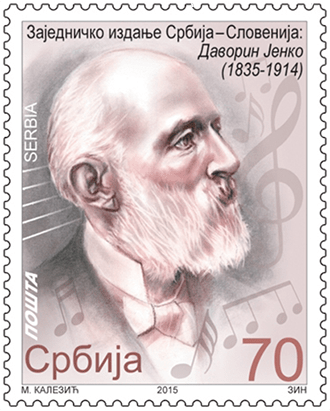



Davorin Jenko
Davorin Jenko (Dvorje, 9 November 1835 – Ljubljana, 25 November 1914) was a famous Slovene and Serbian composer and conductor. Yugoslav by spirit, he was a choirmaster of the Slavic Singing Society in Vienna from 1859 to 1862; at the time he wrote some popular Slovene choral works, among which Naprej, zastave slave later became the national anthem of Slovenia. In the 1860’s he came to Serbia, continuing his work as a choirmaster of the Serbian Church Singing Society in Pančevo, and afterwards inherited Kornelije Stanković as a head of the Belgrade Singing Society. He wrote choral works for the Serbian patriotic poetry. In 1868, when the Royal Serbian Theatre (today’s Serbian National Theatre) was founded, Davorin Jenko was its first conductor. Under the influence of the Serbian musical heritage, he created music for more than 80 plays, among others Đido, The Village Carouser, The Chase, The Sorceress, Pribislav and Božana and several concert ouvertures (Kosovo, Milan, The Serbian Woman, Alexander). He is the author of the music for the Marko’s saber play, by a poet Jovan Đorđević, which was performed in 1872 on the occasion of the accession to the throne of Milan Obrenović, and in which the song Bože pravde, today’s Serbian anthem, was performed.
Davorin Jenko is also a composer of some of the most beautiful old city songs, which are considered to be the folk ones, among others The Reprimand (’De si dušo, ’de si rano), based on the lyrics of Branko Radičević and Tijo noći based on the lyrics of Jovan Jovanović Zmaj. He is deserving of the arrival and engagement of Augusta-Vela Nigrinova, the famous actress. Concertmaster of his orchestra was Petar Krstić, the composer of the music for Koštana, and the cello was played by a poet, Antun Gustav Matoš.
Јенко, представник музике романтизма у Србији, својим делом дао је печат читавом једном раздобљу; усавршио је класичан српски комад са певањем, подигао инструменталну музику на виши уметнички ниво, компоновао прву српску оперету (Врачара или Баба Хрка, праизведена 1882). Заједно са Станиславом Биничким сматра се утемељивачем српске опере. Био је члан Српског ученог друштва (данашње Српске академије наука и уметности), а за своје заслуге одликован је орденом Светог Саве.
Artistic realization of the stamp: MA Marina Kalezić, academic painter.
Museum Exibits

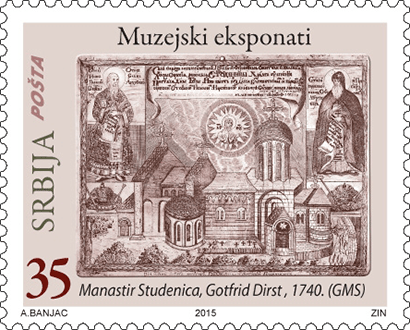






200 Years of the Saint Peter and Paul with the Presentation of Bela Crkva Copperplate
(copperplate on paper, coloured, unknown copperplate engraver, 1815)
Bela Crkva was founded in 1717 according to the plan of settling Banat and securing the border from the Turkish intrusion. The orthodox residents of the prosperous town on the border of the then Austrian Empire wanted to highlight their good incorporation into the political and social circumstances of the time and to protect their confessional and national unity. They succeeded in doing this with the means of the copperplate, which is the work of an unknown author, and it was manufactured according to the drawing of Pavel Đurković or Arsenije Jakšić in 1815. The graphic sheet of this copperplate is dominated by a rectangular field with the saints between which is the temple-front of the Bela Crkva church. On the left and the right there is a text containing a short explanation of the represented, written in big cyrillic letters. In the lesser rectangular, under the saints’ feet, the panorama of Bela Crkva is shown with three parts of the settlement.
275 Years of the Monastery Studenica Copperplate
(copperplate on paper, 1740, the 1965 print, Gotfrid Dirst, the author)
When the presentation of the Church of the Dormition in Studenica was engraved on a copperplate in 1740, the monastery was turning 550 years of its existence. Other than the name engraved below the presentation of the holy object, there are no other recorded data about the purchaser of the copperplate, Nikolaj Antonije Prodanović. Also, almost nothing is known about the author of the copperplate, the Pest graphic, Gotfrid Dirst. Scantiness of data, however, does not belittle the importance of this graphics, because Studenica is the first medieval monument that appears as the main subject in the Serbian graphic arts. The central part of the composition belongs to the Church of the Dormition, an endowment and a crypt of the founder of the Serbian state and the monastery itself, Stefan Nemanja.
275 Years of the Saint Demetrius Icon
(tempera on wood, 1735-1740, author Hristofor Žefarović)
Saint Demetrius icon was painted in the period between 1735 and 1740 by a monk, archdeacon, painter and graphic, Hristofor Žefarović (Dojran, end of XVII century— Moscow, 1753), most versatile Serbian artist of the first half of XVIII century, who signed himself as “Illyrian-Russian common iconographer“.
Saint Demetrius, the patron of cities Thessaloniki and Sremska Mitrovica, protector of Siberia, the Russian area, is painted on a rearing fiery horse, as he stabs Bulgarian tsar Kaloyan, who falls on the grassy surface covered with bunch of tiny flowers. Icon was found in the bell tower of the Church of Three Holy Hierarchs in Novi Sad (Almas church).
Icon and engravings are located in the collection of the Matica Srpska Gallery in Novi Sad.
Expert collaboration: Milena Vrbaški, Museum Advisor, Matica Srpska Gallery in Novi Sad.
The World Champions in Water Polo, Kazan 2015




Next to the name of Serbia on water polo world map it says - world champions, winners of the World League, the World Cup champions, the best in the Mediterranean, bronze at the Student Championship, at the Olympic Games, gold in Europe. Wherever we turn - Serbia, with excellent coaching staff, phenomenal players, teams that constantly want to go further, an audience that follows them and the water polo organization as the support of the entire story.
Water polo is the most trophy sport in Serbia. Numerous water polo workers, coaches and players, on a world scale, occupy a prominent position in the history of this sport, ever since the beginning of the last century when water polo appeared in our region. Brilliant achievements of our country in water polo create the biggest stars of this sport and national teams that achieve the highest awards on the international scene. Serbian water polo team (A selection-seniors) has recorded successes over the past decade in the continuity of the hard work and excellent results, as the winner of the competitions: World Championship 2009, 2015; European Championship 2012, 2014; World League 2006, 2007, 2008, 2010, 2011, 2013, 2014, 2015; World Cup 2010, 2014.
In Kazan, the following players and coaching staff members participated in winning the medal: Gojko Pijetlović (CSM Oradea), Dušan Mandić (Pro Recco), Živko Gocić (Szolnok), Sava Ranđelović (Brescia), Miloš Ćuk (Eger), Duško Pijetlović (Pro Recco), Slobodan Nikić (Galatasaray), Milan Aleksić (Szolnok), Nikola Jakšić (Partizan Raiffeisen), Filip Filipović (Pro Recco), Andrija Prlainović (Pro Recco), Stefan Mitrović (Szolnok), Branislav Mitrović (Eger), with the following coaching staff: Dejan Savić (team selector), Uroš Stevanović, Žarko Petrović (coaches), Stefan Ćirić (coach, cameraman), Vladimir Pavlović (fitness coach – swimming), Aleksandar Janik (fitness coach – gym), Dr. Vladmir Harhaji (physician), Vladimir Radović and Marko Jović (team managers), Vladimir Vujasinović (advisor), Goran Čanković (team leader) and Dejan Stevović (team spokesman).
Graphic realization of the stamp: Jakša Vlahović, academic graphic artist.
Expert cooperation: Serbian Water Polo Federation.
The European Champions in Basketball for Women 2015


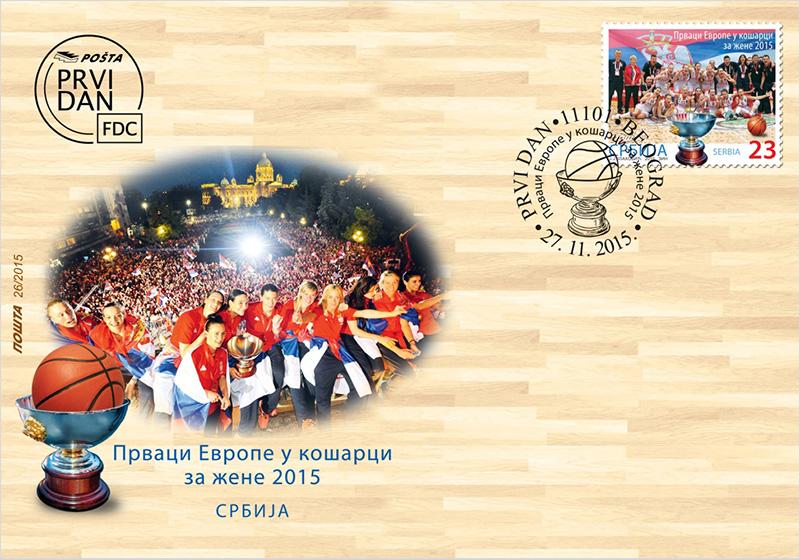

At the European Basketball Championship for Women, held from 11th till 28th of June in Hungary and Romania, Serbian female basketball players won the gold medal.
The Serbian female national team started the group stage of the tournament triumphing over the female basketball players of Latvia, victory over Croatia and the Great Britain and the defeat from Russia. In the second stage of the competition, they met the team members of Slovakia, Spain and Lithuania and, after the triumph over Slovakia and the defeat from Spain and Lithuania, they defeated the national team of Turkey in the quarterfinals.
They won the battle for the finals by the semi-finals victory over Belarus, and triumphing over the French national team in the finals, with the result 76:68, our basketball players achieved the greatest success in the history of the Serbian women’s basketball, and, at the same time, they directly qualified for the Olympic Games in Rio de Janeiro 2016.
Ana Dabović was declared the MVP of the tournament, and Sonja Petrović won the place in all-tournament team.
The gold medal at the European Basketball Championship for Women won: Jelena Milovanović (power forward), Tamara Radočaj (point guard), Kristina Topuzović (small forward), Nevena Jovanović (shooting guard), Danijel Paige (power forward), Tijana Ajduković (center), Saša Čadjo (shooting guard), Sara Krnjić (center), Milica Dabović (shooting guard), Dajana Butulija (shooting guard), Ana Dabović (shooting guard), and Sonja Petrović (power forward), led by the coach Marina Maljković and coaching staff consisting of: Dragan Ratković, Bojan Janković, Miloš Padjen and Miloš Pavlović (assistant coaches), Bogdan Bulj (scout), Miloš Petković (scout), Djordje Jelić (physician), Branko Stojnić (physiotherapist), Marko Salatić (physiotherapist), and Jadranka Trkulja (team manager).
Graphic realization of the stamp: Jakša Vlahović, academic graphic artist.
Cooperation: The Basketball Federation of Serbia.
Two Centuries of tradition of the Serbian Army

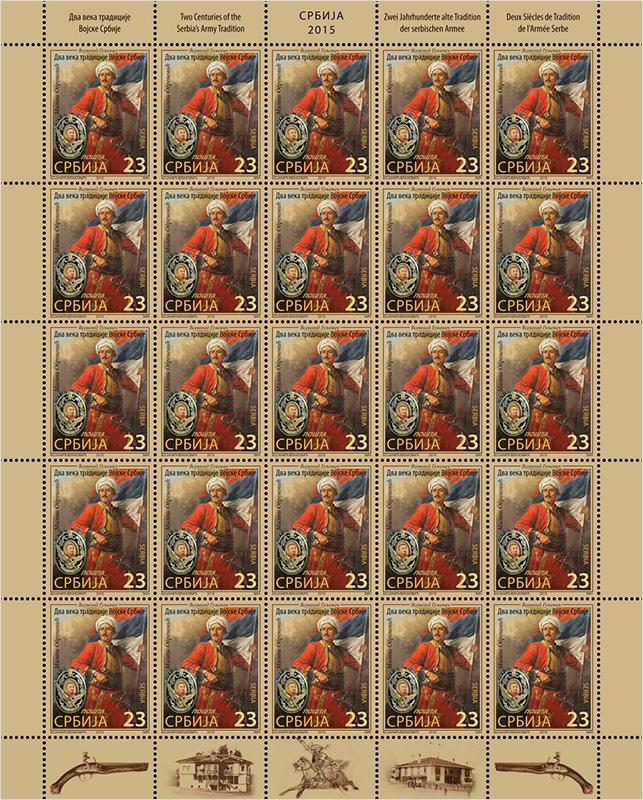
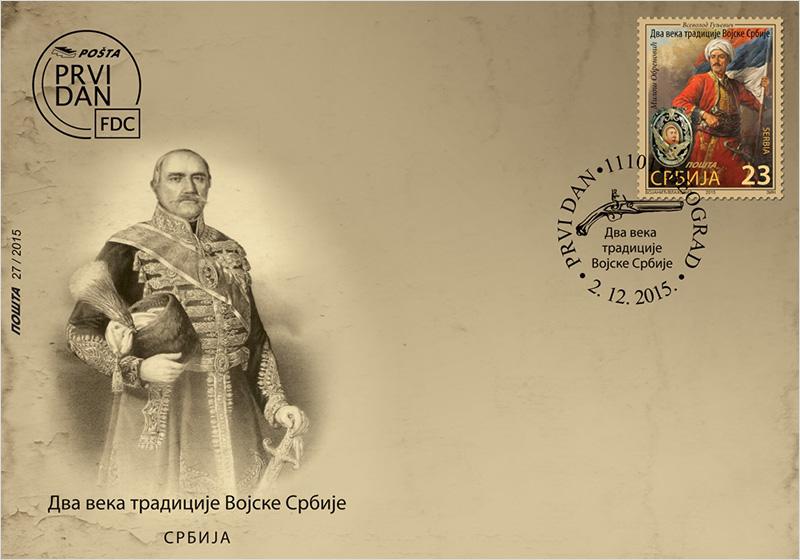

By the Decision on the establishment of the Serbian Army Day and other military holidays (“Official Military Gazette”, No. 21/15), 23 April was designated the Serbian Army Day to commemorate the day when in 1815, on Palm Sunday, the decision on the beginning of the Second Serbian Uprising for the liberation of Serbia from the Ottoman Empire was made.
This date represents a historical turning point that led to the creation of modern Serbian state and enabled the creation of an efficient and modern Serbian army. In addition, besides the beginning of the modernization of society by imitation of European examples and creation of the state and the army, one of the positive consequences of the Second Serbian Uprising is the agrarian reform, which was reflected in the distribution of landowner’s land to peasants.
The Second Serbian uprising, as a complex military-diplomatic and state-building process, symbolically began on Palm Sunday according to the old, or on 23 April 1815 according to the new calendar. Military, diplomatic and political activities of insurgents have led to the Serbia’s liberation from the supreme Turkish authorities, creation of a standing army and establishment of the Guard of the young men from the village houses best “by stature and reputation”.
The National Assembly officially announced the name ‘soldati’ (author’s note: ‘soldiers’), taking into account the fact that the creation of the standing army, first of the “registers” and later of “soldiers”, passed unnoticed by the Porte. Thus, the first recruits were introduced. The standing army lived in barracks and received salary. The first uniforms or ‘mundirs’ were established. These first Serbian regular army formations were modeled after the Austrian army, which is a confirmation that the experiences of foreign armies were used in this period also.
The Second Serbian Uprising itself is the combination of events guided by faith in the liberation of Serbia using existing military assets and military organization which led to the final liberation and recognition of modern Serbia, as a state with full jurisdiction and an international legal subjectivity at the Congress of Berlin in 1878.
The motifs on the stamp: Miloš Obrenović, the work of painter Vsevolod Guljevic and order of Milos the Great of III degree of Marko Lazarević. The motif on the envelope: Knjaz Miloš Obrenović, the author - Anastas Jovanović.
Graphic realization of the stamp: Radomir Bojanić, academic painter, Jakša Vlahović, academic graphic artist.
Expert collaboration: Ministry of Defence of the Republic of Serbia, Department for tradition, standard and veterans.
150 Years of the Gymnasium in Kruševac




150 years ago, the residents of Kruševac and the surroundings managed to bring to life their vision of the opening of the first Gymnasium in this region. At that time, Serbia had just three secondary schools and one seminary. On 9 June 1865, the Kruševac Gymnasium has joined that constellation. In the beginning, it was a semi - secondary school which got its third grade in 1873, and the fourth grade the following year. It worked as a lower Gymnasium until 1888, when it got its fifth grade, and every following year it got another grade. In 1891/92 school year it became a complete secondary school.
An important day in the development of this school is the year 1898 when a government decree was passed in order to abolish its budget financing, but the residents of the city and the surroundings saved it from being closed, making it by their own financial means, a private Gymnasium up until 1902.
During its development process, the Gymnasium faced bigger or smaller temptations. The smaller ones could have been the then prejudices about the schooling of young girls, and those prejudices often influenced the making of decisions about the admission of girls into the Gymnasium. As schooling was only allowed in lower grades, a solution to this injustice was the opening of a private College for girls in 1905 which was necessarily affiliated to the Gymnasium. Unfortunately, real temptations to the survival of the Gymnasium were historical events. During the Balcan War the School was turned into a hospital, while during the World War I it mainly did not work. During the World War II its main purpose was to serve as barracks, while the lessons were given occasionally and improvisationally. The Gymnasium partially changed its appearance in the period from 1977 to 1990 when it worked as an educational center “Bosa Cvetić”.
How much the residents of Kruševac were aware, from the very beginning, of the importance of this school for the development of their region, testifies their enterprising spirit in securing a proper building which was made with their own contributions in 1865. For decades later, in 1908 it was expanded by building up two side wings to the existing object. When the schooling needs became more demanding, either due to the number of students, or the call of modern times, the residents of Kruševac, with the help of the competent ministry, succeeded in creating a new building and moving the school in it in 1938. All these years the Gymnasium knew how to repay the confidence provided, having a great influence with knowledge, spirit and vision on the progress of the Kruševac region.
Today it is a modern school, with four different courses and with over 1000 students, always ready for challenges in the fields of science, art and social engagement. In the constellation of similar schools once so small in Serbia, it glitters in the way that guarantees continuance.
Graphic realization of the stamp: Jakša Vlahović, academic graphic artist.
Expert collaboration: Gymnasium in Kruševac.
The British Heroines of the First World War in Serbia





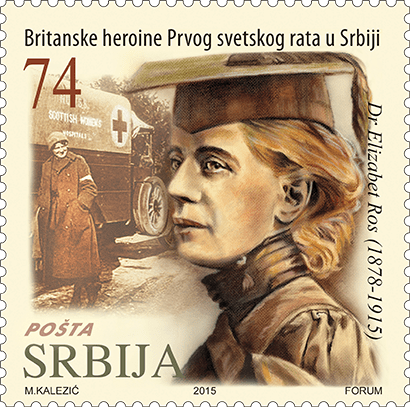



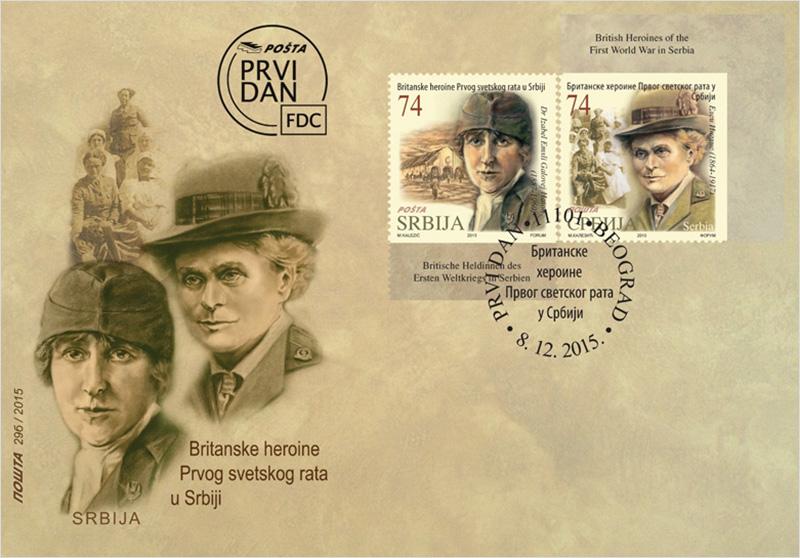


Flora Sandes (Nether Poppleton, Yorkshire, 22 January 1876 – Suffolk, 24 November 1956) was the only female officer of the Serbian army during the First World War and the only woman from Great Britain in the active military service.
When the War started, she voluntarily signed up as a nurse in the Infirmary of Saint John, with which she came to Serbia in August 1914. In Kragujevac she joins the Serbian Red Cross and works as a nurse in the Second Infantry Division of the Serbian army. During the retreat of the Serbian army across Albania, Flora Sands was officially recruited as a soldier and she became the first foreigner in the active service in the then Serbian army.
Together with Milunka Savić she was a member of the “Iron Regiment”. In 1916 she was severely wounded by the enemie’s grenade at the positions near Bitola. Regent Alexander Karađorđević awarded her the Karađorđe Star with Swords and she was promoted into the rank of sergeant. Together with Evelina Haverfield she founded the Serbian Relief Fund. After the War, she was demobilised from the active service in the Serbian army in the rank of captain and continued to live in Serbia. She died in 1956.
Dr. Katherine Stewart MacPhail (Glasgow 1887 – St Andrews 1974), graduated medicine in Glasgow. In January 1915, with the Scottish Women’s Hospital, she arrived to Serbia, Kragujevac, and then proceeded to Belgrade to work at the Military Hospital, Department of Infectious Diseases, with patients suffering from typhoid fever, and Katherine MacPhail herself fell ill as well. After convalescence, as early as spring 1916, she returned to humanitarian work and worked in France, in hospitals where Serbian soldiers were also treated.
After the war, she remained in Serbia and in 1921 she founded the first children’s hospital in our country – English-Serbian Hospital. In 1934 she founded the English-Yugoslav Hospital for Treatment of Osteoarticular Tuberculosis in Sremska Kamenica, which she ran till September 1947. Dr. MacPhail was awarded the Medal of St Sava of the V and IV Order, and for the work in the post-war Belgrade she received the Medal of St Sava of the III Order. She was also awarded the OBE (Order of the British Empire).
Elsie Maud Inglis (Nainitial, 16 August 1864 – Newcastle, 26 November 1917) was a Scottish doctor and the first woman to have been awarded the highest Serbian order – the Medal of the White Eagle. She was also awarded the Medal of Saint Sava.
After the outbreak of the First World War she founded an organization called “Scottish Women’s Hospitals”. In early 1915 she goes to Serbia and establishes the first war hospital. During the retreat of the Serbian army, Elsie Inglis refuses to leave behind the hospital equipment and to retreat with the army, so she gets imprisoned in November 1915 in Kruševac, and afterwards repatriated. She died and was buried in Scotland, and her funeral was attended by the representatives of the Serbian and the Brittish royal families. With her engagement, extraordinary work ethics and personal enthusiasm, she gave a rare example of humanity in the most difficult times and encouraged many other nurses to come to Serbia, the number of which rose to more than six hundred in Serbia in 1915.
Dr. Isabel Emslie Galloway Hutton (1887 – 1960) was a WW1 volunteer since 1915, as a psychiatrist and a member of the Scottish Women’s Hospital. Her unit founded the camp Hospital in Troyes, France, from which Isabel was transferred to Gevgelija (nowadays in Macedionia), from where she quickly retreated to Salonika, to Salonika Front. In summer 1918 she was appointed the Chief Hospital Officer and was transferred to Vranje. She arrived with another 11 physicians and 40 nurses, treating soldiers and civilians in the town where the epidemic typhus and Spanish influenza raged. She remained in Vranje till October 1919 and helped found the local civilian hospital for which she bestowed medical equipment and surgical instruments. She ended her war engagement in 1920, as a commander of a military unit stationed in Belgrade.
For the displayed merits she was awarded the Medal of the White Eagle. Today, the secondary medical school in Vranje bears her name.
Evelina Haverfield (Inverlochy Castle, Scotland, 9 August 1867 – Bajina Bašta, 21 March 1920), was a distinguished women’s rights activist. She came to Serbia in 1915. Together with Dr. Elsie Inglis and other members of of the Scottish Women’s Hospital in Kruševac, she was imprisioned by the occupier together with the wounded.
After the repatriation in 1916 she took part in the organization of the Serbian Relief Fund. In the spring of 1917 Mrs Haverfield unites with three other war veterans, Flora Sands, Emily Simonds and Anna McGlade and establishes the Sands – Haverfield Soup Kitchens which were opened in the Salonika front.
After the liberation she raised a Home for the War Orphans in Bajina Bašta and she helped the tuberculosis patients to be accomodated. She died of pneumonia and was buried in the church yard in Bajina Bašta where, in the memory of her, “The Home – Hospital of Evelina Haverfield” was opened in 1930. Somewhat later, the “Home of Evelina Haverfield” was opened in the curch building.
Evelina Haverfield was awarded the most valuable Serbian medals: the Medal of Saint Sava (IV and V order) and posthumously the Medal of the White Eagle with Swords.
Dr. Elizabeth Ness MacBean Ross (London, 14 February 1878 – Kragujevac, 14 February 1915), a doctor of the Scottish origin, came to Kragujevac, Serbia, in 1915 as a volunteer to treat the severely deseased with typhus.
She is one of the first women with the doctor diploma in Great Britain who came to Serbia as a volunteer. First she went to Niš, then to Kragujevac, which was called the Dead City because of the raging typhus. At the First Reserve Military Hospital at the time of her arrival, there was about 200 patients, and all the doctors and nurses either had already died or were lying among the patients. As Dr. Ross fell down with typhus herself, she worked alone in hard conditions. At the beginning of January 1915 the first unit of the Scottish Women’s Hospital came to Kragujevac, so the staff of the Scottish Women’s Hospital helped their compatriot. After 13 days of fighting typhus fever Dr. Elizabeth Ross died on 14 February 1915 on her 37th birthday. Dr. Elizabeth Ross was buried with full military honours at the cemetery in Kragujevac.
Stamp Day




Centenary of the “King Peter in the Battlefield in 1914” Stamp Issue.
The stamp “King Peter in the Battlefield in1914” was issued in 1915, in the memory of the victory of the Serbian army in the battles fought against the Austro-Hungarian army in the autumn of 1914. On 17 November 1914, when the Serbian soldiers were visited by King Peter I, the then government decided to issue a stamp in honour of this event. The stamp template was made according to a photo of a war photographer Sampson Tchernoff which was made in the battlefield in Garevica near the village of Darosava (Kolubara County). There are King Peter I, Duke Stepa Stepanović, Prince George and the King’s aide, Colonel Knežević in the photo. The Tchernoff’s photo attracted a great publicity – it was first published in a French magazine “Illustration” (L’Illustration), and afterwards on a war postcard of the French issue.
The stamp “King Peter in the Battlefield in 1914” is the first Serbian stamp where the portrait of a sovereign isn’t presented as a classical portrait from the waist up. This stamp is unique in the world partly because King Peter was the only king at the time to have a photo from the front line.
There is an inscription “Srbija” (“Serbia”) on the upper right side of the stamp, and “Kralj Petar na bojištu 1914. godine” (“King Peter in the Battlefield in 1914”) on the lower side. Engraving and making of cliches for the stamps printing were done in Paris, and the stamps, in seven values (5, 10, 15, 20, 25, 30 and 50 pa), were printed at the Serbian Government Printing Works in Niš only in early October 1915, due to difficult communication in the war circumstances.
The stamps were then transported from the Printig Works to the central Stamps Depot for distribution which was in Kruševac at the time. Due to the weak postal traffic, the stamps were only sent to post offices in Gornji Milanovac, Ribarska Spa, Podujevo and Kriva Palanka, and when the offensive of the Austro-Hungarian and German armies ensued, post offices and the Stamps Depot in Kruševac had to be evacuated. In Priština in early November, the Post issued these stamps to citizens to use them instead of coins, and that was also done in Prizren, where the Depot was transferred. In Peć, before the retreat of the Serbian army across Albania in late November 1915, these stamps were destroyed – burned.
Artistic realization of the stamp: Jakša Vlahović, academic graphic artist.
Expert collaboration: Ljiljana Đorđević, curator of the PTT Museum in Belgrade.